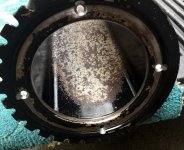I purchased the BX2754A kit from Kubota, very expensive but extremely complete and rather comprehensive. I will offer the following notes based on my progress, should any opt to buy likewise. There are different kits based on whether you have a BX2750 variant, BX5450 or BX2816. I believe BX2750 exists as base, A B C and D based on vintage and subtle changes. The base version in each variant is with a hand crank with a wire worm and matching wheel. I have a BX2750B. The instructions suggest modifications required if not originally equipped. One was drilling the housing for hydraulic motor mounting bracket, mock up, match mark, drill, no big deal, done. Instructions suggest that hole may already exist as a slot. In my case, no, I expect it exists on BX2750C BX2750D.
Next, chute modifications for dedicated gear for hydraulic motor and gear, once again, instructions suggest four holes may or may not be present. In my case, BX2750B, no holes, likely pre-drilled on BX2750C and BX2750D. I believe not applicable on BX5450 and BX2816. It seems that on those models, RAD, Kubotas supplier, changed the wheel on the chute to be in fact standard with a finer tooth gear that matches what must be added on the BX2750 for the motor gear. On the BX5450 and BX2816, there is a finer wire worm that meshes in this gear, the gear that works for both manual and hydraulic rotation. Hence, change from any BX2750 variant to the BX5450 is not just a number change, it is a design change.
Instructions in my case suggest to slip new gear over chute and piggy back original manual rotation wheel, center new gear over original wheel and match drill four 1/4" holes. Then, using those four holes as pilots, drill 1/2" from underneath to depth just enough to recess flat head screws to just below flush. Here are the issues with that.
When I placed the gear over the wheel from the top, It could not be centered. The inner profile of the gear interfered with sheet metal of the shroud, either from lack of internal gear clearance or variance of location of shroud weldment relative to wheel. Ultimately, I placed gear on the bottom side of the wheel, centered, transfer punched holes, then drilled. When I finally do mount the gear topside, I will either have to relieve the inside of the gear on that corner, notch or dent the shroud to allow centering to catch the holes I drilled.
Next is the 1/2" drilling from beneath to sink the flat heads below flush. I'm not suggesting that this won't work but when you are drilling heavy gauge sheet metal and need to accommodate the angularity difference of the drill point and the profile of a flat head screw, there sure can't be much metal left if you sink it to below flush. I believe a standard drill point is perhaps 37 degrees and the angle of the flat head nearer to 90! I ended up purchasing and using a 1/2" countersink. IIRC, the angle is 82 degrees on the countersink and it's close to the angle of the flat head if not exactly the same.
Nice kit, but it's no cake walk!








